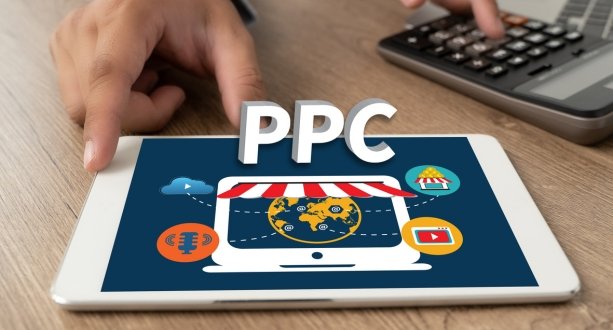Pay Per Click
Pay-per-click (PPC) is an internet advertising model, in which a publisher (such as a search engine, website owner, or a network of websites) pays an advertiser when a user clicks on an ad.
PPC gives advertisers the opportunity to reach a specific audience and promote their products or services to them. With PPC, the advertiser pays a fee each time one of their ads is clicked by a visitor. Search engines and websites use PPC to drive traffic to their websites.
The Google algorithm uses complex algorithms to determine which advertisers should be shown to users based on the keywords they are searching for.
Advertisers bid on keywords, and the publisher chooses the advertisers with the highest bid and quality score. The advertisers who bid the most are the ones who are shown to the users. With the pay-per click model, advertisers pay when users click on their Google Ads.
The ad auction takes place every time a user searches for a keyword phrase. Google Search Ads are a combination of text, images, and shopping ads that appear in Google search results when a users search query is matched to the keywords you have chosen.
The more relevant your ads are to your target market, the more likely they are to be clicked on. Search engines like Google are designed to help users find what they are looking for.
Search ads, also known as text ads, are an advertisement that appears in search engine results pages (SERP) when people search for something on Google or another search engine.
Search ads are one of the most common types of pay per click ads, and they are at the center of a PPC campaign. Search network- Search engines reward advertisers who get a high number of search-ad clicks.
This is because users are more likely to click on an advertisement if it is relevant to their search query. The higher the number of clicks, the higher the ranking of the advertisement.
The online advertising model allows advertisers to use systems like Google Ads, Facebook, and other marketing platforms, to target a user at a time when the user is most likely to take a valuable action (click).
The value of the click is determined by the audience type and the relation between the user and the advertiser’s website or app. The more the user interacts with the ad, the more the advertiser will pay. The online ads reward ads that are relevant to the product or service, and the keywords that the user searches for.
In addition, an advertiser can pay a substantial amount of money for a visit to a website. This is because the cost of converting a potential customer is high.
There are multiple options for publishers, clients and freelancers to earn money through pay per click advertising. Affiliate programs are third-party programs that pay the publisher for referring a client.
Benefits Of Pay Per Click Advertising For Businesses
Pay Per Click (PPC) advertising is a popular marketing channel in the realm of internet marketing. With PPC, businesses can create online ads targeted at their desired target audience.
When users click on the ad, the business pays a set fee to the platform hosting the ad. This allows companies to more accurately control their budget and maximize their return on investment (ROI). Additionally, PPC helps generate more traffic to a brand’s website or products page and increases visibility among potential customers.
Pay-per-click (PPC) is a digital advertising model in which advertisers pay each time someone clicks on their ad. This user click-based model makes it easier for businesses to measure their return on investment from digital advertising, providing a cost saving measure compared to traditional print advertising.
The great bargain of PPC is that you only pay when someone clicks the ad, meaning that you don’t have to pay for impressions or reach.
For example, if an advertiser pays $1 per click, and 1000 people view the ad but no one clicks it, there’s no cost associated with it. Google AdWords is one of the most common platforms used for PPC ads and can be an effective saving measure when used strategically.
PPC Click Advertising, also known as Pay Per Click Advertising, allows businesses to pay for ads to be displayed on search engine result pages.
This type of advertising offers many advantages for businesses such as allowing them to control their budget and reach the right audience. Furthermore, it gives them access to detailed performance information such as link clicks and cost per impression.
Google Ads is not the only option available, Bing Ads is a great alternative and can be used in combination with Google Adwords or on its own. With an effective PPC campaign, you can get up to 100 000 impressions per day at a fraction of what it would cost you through other advertising options.
The performance details will allow you to track your success and make necessary adjustments if needed.
Pay per click (PPC) advertising is one of the most popular content marketing strategies that marketers use to increase brand awareness and acquire new customers.
PPC advertising is a form of online advertisement in which advertisers pay each time one of their ads is clicked. It can be used on various social media sites, as well as Google Ads, to reach new audiences and generate more leads for businesses.
This type of advertising allows businesses to target certain keywords and demographics with their campaigns, making it more cost-effective than traditional marketing methods.
Additionally, it provides immediate results since you only pay when someone actually clicks on your ad so you don’t have to wait for long periods of time to get the desired outcome from your campaign.
Furthermore, PPC ads are extremely flexible and allow marketers to adjust their campaigns on a regular basis according to their changing needs or goals.
This makes it easier for businesses to be in control of their ad spend and the placements of their advertisements.
With PPC models, businesses have the ability to target customers on social media sites and platforms, such as Facebook and Twitter, as well as search engine ads that appear when users search for relevant terms. Overall, pay per click advertising offers a great number of benefits for businesses.
It helps them gain visibility on popular search engines like Google and Bing as well as social media sites like Facebook and Twitter.
By being able to control where their ad spend is going, businesses can optimize their campaigns in order to reach more potential customers with relevant advertisements.
With its flexibility, PPC models give marketers the power to adjust campaigns according to ever-changing needs or goals while still achieving desired results over time.
Different Types Of Pay Per Click Advertising Platforms
Google Ads offers paid search advertising, shopping ads, video ads, display ads, and Gmail Sponsored ads. Advertisers can run pay per click (PPC) advertising campaigns on Google Search, Google Display Network (GDN), Bing Ads, and YouTube.
Google Search is a search engine results page ad platform that allows advertisers to bid on a selection of keywords to appear at the top of the search results.
The Google Display network is an advertising platform where advertisers can bid to appear on third party websites and popular sites across the web.
In addition to Google AdWords, Google also offers paid advertising solutions for mobile app developers to promote their apps on mobile devices.
You can run a shopping or display campaign on Gmail sponsored advertising.
For example, if you are running a social media advertising campaign on TikTok, you can use Gmail as a type of PPC platform. You can also run remarketing campaigns on specific platforms to target audiences who have previously visited your site.
If you have a display campaign running on GDN, you will be able to remarket to users who have visited your display campaign.
You can use custom search bars on social platforms like Facebook, LinkedIn, and Instagram. You will need to pay money to have your brand appear at the top of the search engine results page.
Depending on your needs you can run PPC ads, marketing ads, or both. PPC Ads are text-based ads that appear on search engines and social platforms.
Google Search Network Campaigns – Google Ads allows you to run text ads on the Google Search Partner Network, which includes Bing and Yahoo.
When a user searches for a keyword that you have chosen, your ad will appear on the search query. Microsoft Ads – Microsoft Ad is a separate advertiser platform, but it allows you run text and shopping campaigns.
When users search for bing, your ads will appear based on the keywords you choose, the information in your product feed, and other components of your PPC campaign.
A large handful of Google and Bing-eligible ads are displayed in the search results.
Google Shopping Ads enable ecommerce advertisers to display their products directly in Google search. You will need to provide key details about your business and the products you sell.
Google will then display your ads when a search is made for the keyword you have provided as input into your Google shopping ads.
Facebook Ads Manager – Facebook ads allow you to target specific audiences by demographics like age, gender, location, interests and other factors like behaviors and connections to your business.
You can also use tools like Google AdWords to target your ads to specific demographics and locations. You do not have to pay for leads that do not convert into sales.
Conclusion
Pay Per Click (PPC) advertising is a powerful tool for businesses looking to drive targeted traffic to their website, increase brand visibility, and boost sales and revenue.
By leveraging the right keywords, ad copy, landing pages, and targeting options, businesses can create highly targeted and effective PPC campaigns that deliver measurable results.
However, to succeed in PPC, businesses need to constantly monitor and optimize their campaigns, experiment with different strategies, and stay up-to-date with the latest industry trends and best practices.
By following these guidelines and working with a professional PPC agency or expert, businesses can maximize the ROI of their PPC investments and achieve their marketing goals.
Frequently Asked Questions
Some key components of a successful PPC campaign include keyword research, ad copy and design, landing page optimization, targeting options, bid management, and tracking and analysis.
The amount that businesses should spend on PPC advertising varies depending on their industry, target audience, goals, and competition. It’s important for businesses to set a realistic budget based on their goals and track their spending and ROI carefully.
Some common mistakes to avoid in PPC advertising include poor keyword targeting, irrelevant ad copy, low-quality landing pages, inadequate tracking and analysis, and overbidding on keywords.
Businesses can optimize their PPC campaigns by constantly testing and refining their keyword targeting, ad copy and design, landing pages, targeting options, bid management, and tracking and analysis.
Some best practices for PPC advertising include conducting thorough keyword research, creating high-quality and engaging ad copy and design, optimizing landing pages for conversions, targeting the right audience, tracking and analyzing key metrics, and constantly testing and refining campaigns.




